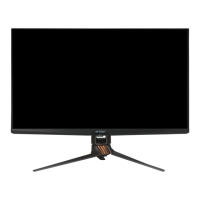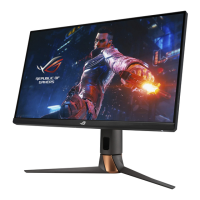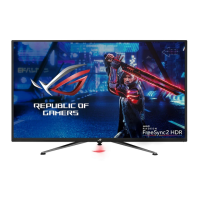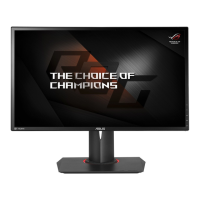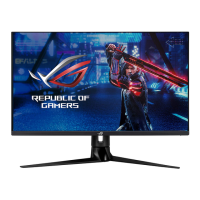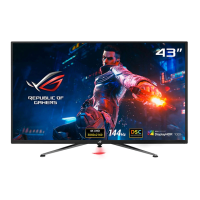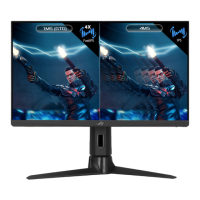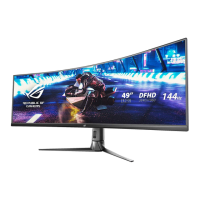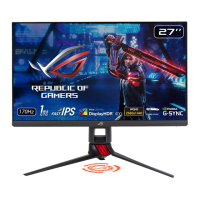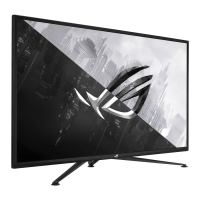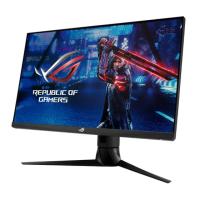
Do you have a question about the Asus REPUBLIC OF GAMERS ROG STRIX XG279Q and is the answer not in the manual?
| Color | black |
|---|---|
| Screen Type | led |
| Tiltable | yes |
| Touch Screen | no |
| Webcam | no |
| OS Compatibility | windows |
| Screen Size | 27 inches |
| Panel Type | ips |
| Aspect Ratio | 16:9 |
| Resolution | 2560 x 1440 |
| Native Resolution | 2560 x 1440 |
| Refresh Rate | 120hz |
| Response Time | 1 milliseconds |
| Brightness | 400 candela per square meter |
| Contrast Ratio | 1000:1 |
| Synchronization | g-sync compatible (nvidia adaptive sync) |
| Horizontal Scan Rate | 222 kilohertz |
| HDR | no |
| Built-In Speakers | yes |
| HDMI Ports | 2 |
| Voice Assistant | no |
| Depth with Stand | 10 63/100 inches |
| Height with Stand | 21 17/50 inches |
| Width with Stand | 24 1/10 inches |
| Depth without Stand | 3 1/5 inches |
| Height without Stand | 14 2/5 inches |
| Net Weight without Stand | 8.82 pounds |
Essential safety guidelines for using the monitor, covering electrical hazards, ventilation, and proper handling.
Information on how to dispose of the product according to environmental regulations.
Instructions on how to clean the monitor surface safely and effectively using appropriate materials.
Describes expected behaviors like screen flicker, uneven brightness, and afterimages.
Provides links to ASUS websites for updates and mentions optional documentation.
Information on ASUS's commitment to responsible recycling of products and components.
A welcome note thanking the user for purchasing the ROG gaming monitor.
Lists all items included in the monitor package for user verification.
Identifies front/side components and explains the function of each control button.
Details the various ports located on the back of the monitor and their uses.
Guide on how to activate and utilize the GamePlus toolkit for gaming enhancements.
Explains how to activate and use different GameVisual picture modes for optimal viewing.
Details HDR format support and unavailable functions when HDR is active.
Step-by-step instructions for attaching the monitor arm and base.
Guide on how to change the film on the LED projection cover.
Instructions on how to organize cables using the input/output port cover.
Guidance on adjusting the monitor's tilt, swivel, and height for optimal viewing.
Instructions on how to pivot the monitor for portrait viewing.
Steps to detach the monitor arm for VESA wall mount installation.
Instructions for connecting power, display, and USB cables to the monitor.
Steps to power on the monitor and identify the power indicator status.
Detailed steps on how to navigate and reconfigure settings within the OSD menu.
Explains OSD functions related to gaming like Overclocking, OD, Adaptive-Sync, ELMB SYNC, GamePlus, GameVisual, Shadow Boost.
Details on adjusting brightness, contrast, HDR modes, dynamic dimming, ASCR, aspect ratio, and blue light filter.
Provides advice and exercises to minimize eye strain during prolonged use.
Explains settings for Color Temp., Gamma, and Saturation for color calibration.
Guide on how to select the desired input source from HDMI or DisplayPort.
Details on Aura Sync, Aura RGB effects, and LIGHT IN MOTION settings.
Covers saving/loading settings (MyFavorite) and system configurations like language and OSD setup.
Details on sound settings, volume control, mute, and USB hub functionality.
Explains power indicator, power key lock, key lock, and OSD setup options.
Information on DisplayPort version compatibility and how to perform a factory reset.
Steps to activate and use the AURA software for controlling RGB lighting effects.
Guide on adjusting AURA lighting options, effects, colors, and brightness.
Detailed technical specifications of the ROG Strix XG279Q monitor.
Lists all the accessories that come with the monitor package.
Lists various compliance certifications and standards the monitor adheres to.
Diagrams and measurements showing the physical dimensions of the monitor.
Provides solutions for common issues like power, screen display, and color defects.
Table detailing supported resolutions and refresh rates for HDMI and DisplayPort.
Details supported video timings and refresh rates for different resolutions via HDMI and DP.
